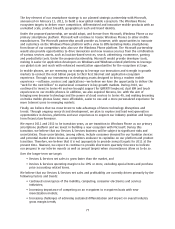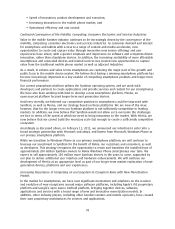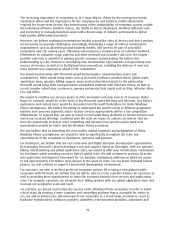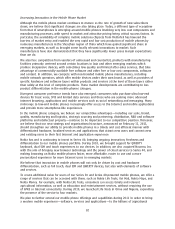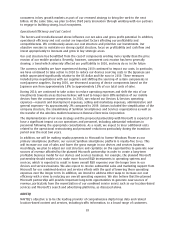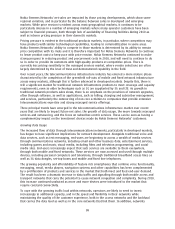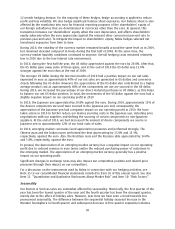Nokia 2010 Annual Report Download - page 86
Download and view the complete annual report
Please find page 86 of the 2010 Nokia annual report below. You can navigate through the pages in the report by either clicking on the pages listed below, or by using the keyword search tool below to find specific information within the annual report.Quality and Richness of LocationBased Content and Services Will Continue to Increase
In addition to the factors driving net sales discussed above, NAVTEQ’s profitability is also driven by
NAVTEQ’s expenses related to the development of its database and expansion. NAVTEQ’s development
costs are comprised primarily of the purchase and licensing of source maps, employee compensation
and thirdparty fees related to the construction, maintenance and delivery of its database.
In order to remain competitive and notwithstanding the price pressure discussed above, NAVTEQ will
need to continue to expand the geographic scope of its map data, maintain the quality of its existing
map data and add an increasing list of new locationbased content and services, as well as using
innovative ways like crowd sourcing to collect data. The trends for such locationbased content and
services include realtime updates to location information, more dynamic information, such as traffic,
weather, events and parking availability, and imagery consistent with the realworld. We expect that
these requirements will cause NAVTEQ’s map development expenses to continue to grow, despite a
number of productivity initiatives underway to improve the efficiency of our database collection
processing and delivery.
Industry Developments Impacting NAVTEQ
Sales of our map database on handsets grew in 2010 as a result of rapid deployment of navigation by
handset providers globally and by wireless carriers in the US. While the global economic environment
appears to only gradually be strengthening, we expect to see continued growth in navigation on
mobile devices in 2011. Sales in the automotive sector also increased in 2010 as a result of higher
automobile sales in Europe and North America. We expect sales of our map database in the
automotive sector to remain steady in 2011, but expect the percentage of NAVTEQ net sales derived
from invehicle navigation to decline in 2011 compared with 2010 and the percentage derived from
handsets to increase compared to 2010. We also expect sales of our map database used in PNDs to
decline in total and as a percentage of NAVTEQ net sales in 2011, compared to 2010.
Nokia Siemens Networks
Nokia Siemens Networks is one of the leading providers of telecommunications infrastructure
hardware, software and professional services globally. After the completion of the expected Motorola
acquisition discussed below, Nokia Siemens Networks believes that it would be the second largest
such provider globally by revenue.
Nokia Siemens Networks’ net sales depend on various developments in the global mobile and fixed
network infrastructure and related services market, such as network operator investments, the pricing
environment and product mix. In developed markets, operator investments are primarily driven by
capacity and coverage upgrades, which, in turn, are driven by greater usage of the networks both for
voice calls and, increasingly, for data usage. Those operators are increasingly targeting investments in
technology and services that allow better management of users on their network, and also allow
them additional access to the value of the large amounts of subscriber data under their control. Also,
in developed markets, the investments of network operators are driven by the evolution of network
technologies and an increasing need for efficiency and flexibility. In emerging markets, the principal
factors influencing operator investments are the continued growth in customer demand for
telecommunications services, including data, as well as new subscriber growth. In many emerging
markets, this continues to drive growth in network coverage and capacity requirements.
The telecommunications infrastructure market is characterized by intense competition and price
erosion caused in part by the entry into the market of low cost competitors from China, which look to
gain market share by leveraging their low cost advantage in tenders for customer contracts. The
pricing environment has remained intense in 2010 as the rise of the low cost vendors from China
continues. In particular, the wave of network modernization that has taken place, particularly in
Europe, has seen some aggressive pricing as Chinese vendors attempt to break into these markets.
85




